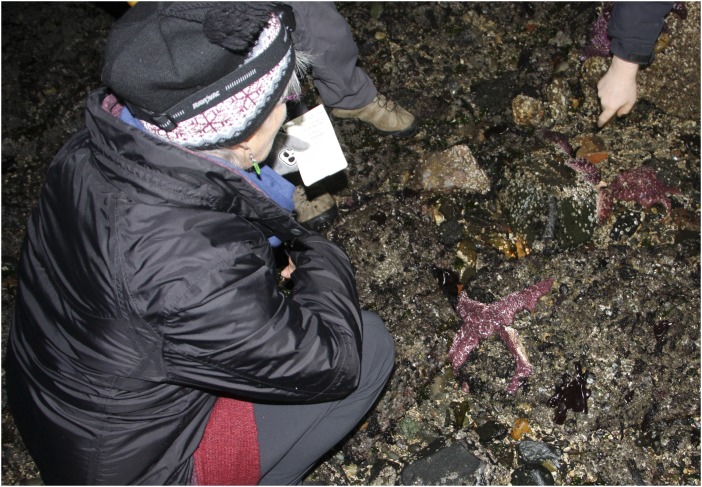In June of last year, researchers got the first report that sea stars in Washington’s Olympic National Park were succumbing to a new disease outbreak. By August, stars were falling off the rocks—dead by the thousands—at Vancouver Island. “That’s the point at which we started getting samples and alerting people,” says Drew Harvell, a marine epidemiologist at Cornell University in Ithaca, New York, who is part of a team now sleuthing the outbreak’s cause. “We’re looking, but it’s hard to figure out what’s going on.”
At Alki Beach, Seattle, Drew Harvell examines sea stars suffering from a mysterious condition that causes lesions, which break the stars apart. Image courtesy of Laura James.
The still-mysterious condition effectively deflates the animals, causing growing lesions that break their bodies apart. Reports of further losses from the disease, which has all but eradicated multiple sea star species in certain spots, now stretch from Alaska to Mexico. It has been called “sea star wasting syndrome” because some of the signs resemble those of conditions seen before on both North American coasts. However, this may be a misnomer, as the ongoing event has a number of characteristics distinguishing it from past known outbreaks.
Rather than a wasting them away, the condition can progress quite rapidly, even in very healthy animals. Although typical outbreaks affect a single species and end with the onset of winter, the current outbreak is hammering at least a dozen species and still going strong as spring approaches.
Harvell is currently on sabbatical at the University of Washington’s Friday Harbor Laboratories. She is working with Ian Hewson, a microbiologist at Cornell, and other colleagues, to collect and process samples in hopes of understanding what is happening. The condition is likely infectious, but they can’t yet identify the transmission route. This identification is always a challenge, but particularly in marine research, where resources are more limited than for human epidemiology.
Nonetheless, genetic sequencing has identified bacteria and viruses—potential causative agents—present in sick animals that aren’t found in their healthy counterparts. The team is working to pinpoint the actual cause, work that for safety reasons is proceeding under quarantine in the only suitable facility available, a fish virus laboratory.
The photo is from a recent sample collection trip to a beach in Seattle, where Harvell (pictured at left) discovered relatively good news. Multiple sea star species have been virtually eradicated in the site’s subtidal zones, but higher up in the intertidal zone they found over 130 stars that night. About half were diseased, including the one shown here with one leg missing and one mangled.
Harvell says it’s too soon to say what the ecological implications of such a large loss will be. However, she points out that one of the species hit hardest, the ochre star, was the focus of the seminal paper that introduced the term “keystone species,” a species whose populations keeps others in check. The ochres are especially important in keeping mussel populations from overtaking rocky habitats, and all of the species affected are predatory. “There’s just no question there’s going to be a huge impacts for the subtidal seascape,” says Harvell, “An event this large will probably have a big impact on their population biology.”



